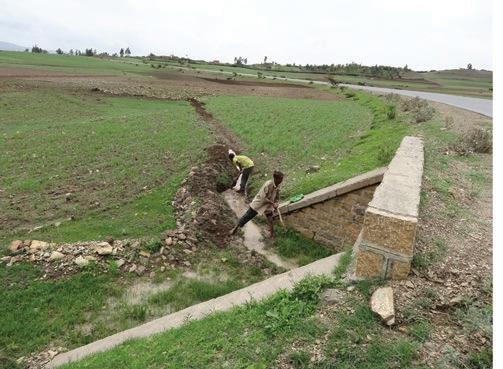
4 minute read
2.4 V-shaped floodwater spreader
• Proper design and protection measures on the downstream sides of culverts depend upon the soils and slope immediately downstream but may include the following: – V-shaped floodwater spreaders (see photo 2.4) – Check dams and stepped drop structures – Riprap protection – diversion channels to take runoff to benefiting areas, storage, or recharge structures • Proper design of the culvert is required, particularly in steep, erodible streams.
The lower sill of the culvert can be raised and help stabilize the stream and prevent further scouring out of the stream.
Advertisement
Planning water-harvesting and erosion control measures along with roads
Rural roads’ contribution to erosion is well documented and can be clearly seen in roadside gullies, landslides,2 and the presence of road aggregates washed from the surface of unpaved roads. Measures to control and prevent erosion should be part of road construction and maintenance. The following important measures are discussed in this chapter as well as in chapter 10: well-placed road alignments (slope, bends, and drainage system), check dams, infiltration bunds, rolling dips and water bars, reinforced culverts, and water spreaders.
The road represents a change in the natural topography, opening fresh slopes that may be protected by several mechanical and biological measures. These erosion-control measures must be introduced simultaneously with the road’s development to keep erosion from occuring.
There are several methods for biological treatment. The two most popular are bioengineering and the use of stabilizing plants, in particular vetiver grasses (Chrysopogon zizanioides). Bioengineering is the use of plants for slope stabilization and runoff control. It involves using plant parts such as
PHOTO 2.4
V-shaped floodwater spreader
roots, cuttings, and stems as a cost-effective and locally adaptable means of erosion control. Bioengineering ranges from planting deep-rooted species to a combination of vegetation and civil engineering structures. Examples of bioengineering include planting grass lines along contours vertically or diagonally, turfing, jute netting together with seedlings, brush layering, fascines, palisades, wattling, live check dams, bamboo fencing, and vegetated stone pitching (devkota et al. 2014).
Vetiver grows in practically any soil and therefore also performs well in soils, such as fresh cut and fill areas, that are devoid of nutrients (Greenfield 2008). Its deep roots make vetiver able to withstand high runoff speeds and volumes. Vetiver is also a very resilient plant that can grow under a wide range of climate conditions, including air temperatures ranging from −15o C to more than 55o C and rainfall varying from less than 300 millimeters to more than 5,000 millimeters per year. Given this versatility, vetiver has a range of uses, including slope stabilization, vegetation rehabilitation, and as a source of fodder and thatch (Pinners, n.d.). Planting parallel hedges of vetiver on steep slopes can control runoff erosion related to road construction or drainage. Although common in some countries, several proven uses of vetiver have not been introduced in many other countries where they could make a significant contribution. The same applies for bioengineering. Although some countries (for example, nepal) are very proactive in bioengineering, it is relatively unknown in other countries.
There are other ways that roads can contribute positively to erosion control in watersheds, including stabilizing erosive streams with small road fords or drifts, controlling erosive areas with embankment roads, and combining warping dams with roads.
Stabilizing Streams with Road Platforms Road platforms or small fords may be placed at erosive stream crossings to stabilize them. These structures will retain the streambed material and allow water to spread over the breadth of the road body before it is discharged downstream, which will make stream flows much gentler. If such road platforms are raised on the uphill side, they can help stabilize the stream and even build up a small sandy layer in the streambed that can act as water storage and connect to the aquifer surrounding the stream. Chapter 9 discusses the principle of such road drift’s acting as sand dams in greater detail. If a riverbed is filled with a thick layer of sand gravel, the river can feed the groundwater adjacent to it. Building a series of such stabilizing structures on a stream at different road crossings is the preferred option. Small sand dams may be added in some cases. note that such structures can have a significant adverse impact on aquatic life in the stream, and that the design of any structure within a stream or river should be carefully considered to balance all concerns.
Fords may be straight with a dip or depressed section (see figure 2.6) that will divert the runoff from the road surface and guide the water from the stream. The ford may also be parabolic in shape, mainly to facilitate natural streams overpassing the road. The advantage of parabolic fords is that they spread the water over a larger width of the riverbed, causing less damage to the streambed and stopping whatever rutting that may appear in the riverbed. The fords also hold the bed material in place. A further advantage of such stream crossings is that they do not become clogged. The key disadvantage of fords is that the road may not be passable during short-term floods; fords are therefore most appropriate on low-volume roads.








